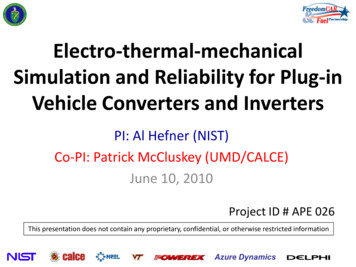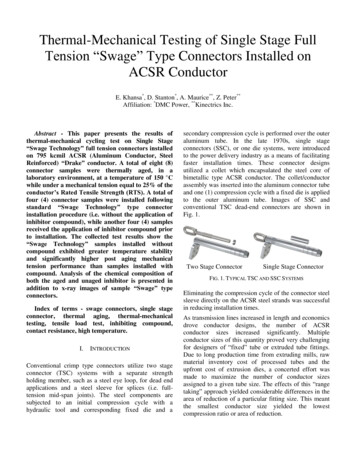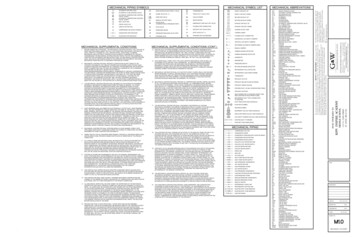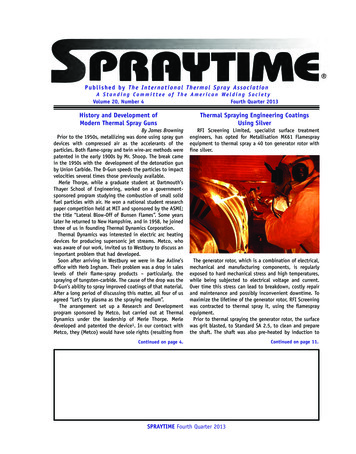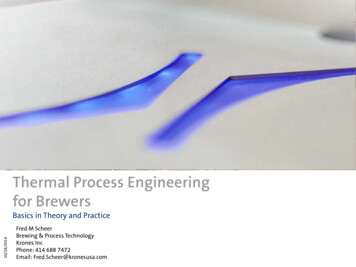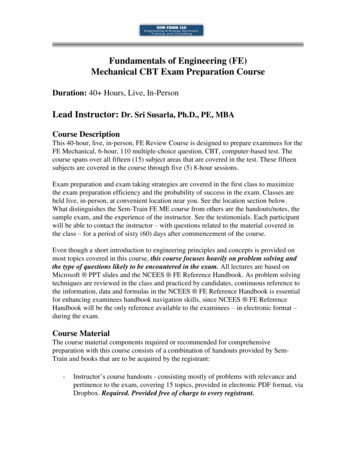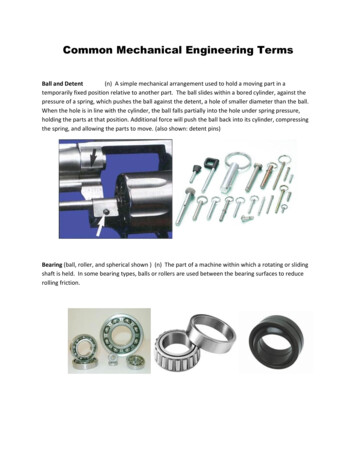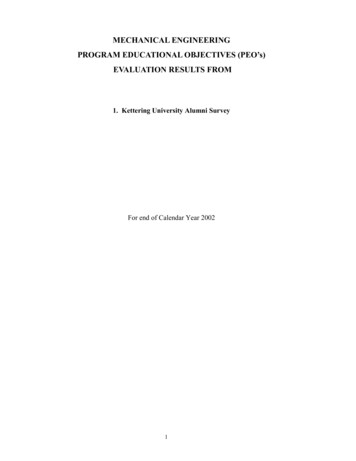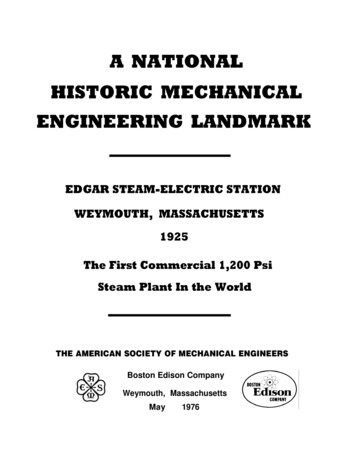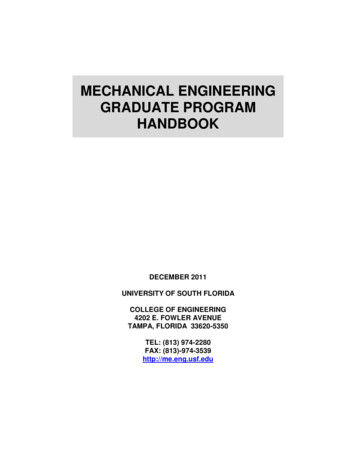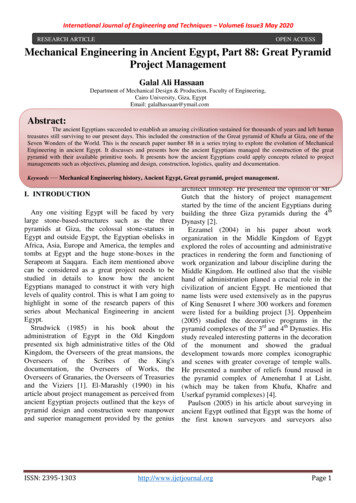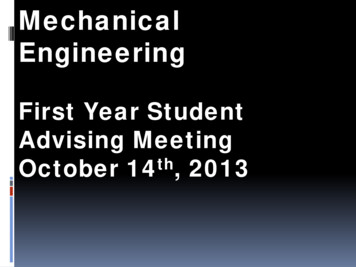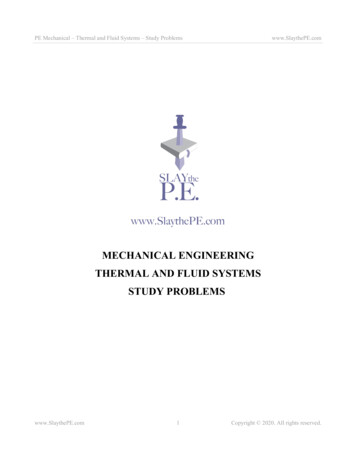
Transcription
PE Mechanical – Thermal and Fluid Systems – Study Problemswww.SlaythePE.comMECHANICAL ENGINEERINGTHERMAL AND FLUID SYSTEMSSTUDY PROBLEMSwww.SlaythePE.com1Copyright 2020. All rights reserved.
PE Mechanical – Thermal and Fluid Systems – Study Problemswww.SlaythePE.comHow to use this bookThis study problems book works on what we call the “principle of progressive overload”. With thistechnique you start with very easy problems and smoothly progress towards more complex problems.A good example of progressive overload is the story of the famous wrestler Milo of Croton in ancientGreece. This extraordinarily strong man was allegedly capable of carrying a fully grown bull on hisshoulders. He was reported to have achieved this tremendous strength by walking around town with anew born calf on his shoulders every single day. As the calf grew, so did the man's strength.We recommend you work the problems in this book in the order they are presented. Within eachsection of the book, the first problems will feel “light”, like carrying that baby calf – you might even betempted to skip them. We strongly urge you to resist this temptation. As you progress, the problemsbecome harder, but the work you've been putting in with all the previous problems will bear fruit. Youwill be pleasantly surprised at how relatively easy those “hard” problems will seem. You will soon becarrying intellectual bulls on your shoulders! The problems that are considered “exam-leveldifficult” are denoted with an asterisk.The book is divided into 5 parts with multiple sections within each part. Generally, the sections are notindependent and build from the previous ones. We recommend you go through them in the orderpresented, and be sure to review them all. Each section begins with a brief discussion of the relevantconcepts and equations. These discussions are laser-focused on the aspects that are relevant to the P.E.exam and do not go into derivations with academic rigor.Starting in 2020, the only reference allowed in the exam is the NCEES PE Mechanical Handbook(PEMH) which you will have in the computer screen. We will use bold text in blue through this bookwhenever we refer to a table, equation, or graph from the PEMH.www.SlaythePE.com2Copyright 2020. All rights reserved.
PE Mechanical – Thermal and Fluid Systems – Study Problemswww.SlaythePE.comTABLE OF CONTENTSPART I: THERMODYNAMICS & ENERGY BALANCES01: Mass and Volume Flow Rates . 502: Mass Balances . 903: Introduction to Energy Balances . 1704: Control Volume Analysis – Incompressible Liquids . 2505: Control Volume Analysis – Ideal Gases . 3706: Control Volume Analysis – Saturated Mixtures & Superheated Vapors . 5507: Entropy Balance, Isentropic Processes & Isentropic Efficiency . 8508: The Carnot Cycle (Heat Engines, Heat Pumps and Refrigerators) . 11309: The Rankine Cycle . 12310: The Brayton Cycle . 15111: Vapor Compression Refrigeration Cycles . 16512: Otto and Diesel Cycles . 18113: Gas Mixtures . 19514: Combustion . 20115: Combined Power Cycles . 219PART II: FLUID MECHANICS & HYDRAULICS01: Basic Information and Properties of Fluids . 22702: Classification of Flows, Terminology & Bernoulli Equation . 25303: Control Volume Analysis – Conservation of Mass & Energy . 26904: Control Volume Analysis – Conservation of Momentum . 29205: External Flows: Flows over Immersed Bodies . 30606: Internal Flows: Pipe Flow . 31607: Simple Pipe Networks . 34408: Turbomachines . 36209: Compressible Flow – Isentropic Flow & Nozzles . 37610: Compressible Flow – Normal Shockwaves . 39011: Compressible, Adiabatic Duct Flow with Friction (Fanno Flow). . 400PART III: PSYCHROMETRICS & HVAC01: Properties of Moist Air . 40802: The Psychrometric Chart . 41803: Simple Cooling and Heating . 426www.SlaythePE.com3Copyright 2020. All rights reserved.
PE Mechanical – Thermal and Fluid Systems – Study Problemswww.SlaythePE.com04: Adiabatic Mixing of Air Streams . 43405: Cooling with Dehumidification and Heating with Humidification . 44006: Evaporative Cooling . 45207: Wet Cooling Towers . 458PART IV: HEAT TRANSFER & HEAT EXCHANGERS01: Introduction . 46802: 1D Steady State Conduction – The Plane Wall . 48203: 1D Steady Conduction – Radial Systems & Fins . 50004: Transient Conduction – The “Late” Regime . 51605: Transient Conduction – The “Early” Regime . 52806: External Forced Convection . 53607: Internal Forced Convection . 54408: Natural Convection . 55809: Heat Exchangers: Log Mean Temperature Difference Method . 56410: Heat Exchangers: Effectiveness-NTU Method . 58111: Radiation Heat Transfer . 591PART V: GENERAL ENGINEERING & SUPPORTIVE KNOWLEDGE01: Economic Analysis . 59702: Linear Programming . 61503: Introduction to Mechanical Properties of Materials . 62504: Introduction to Stresses in Pressure Vessels . 63305: Statics – A brief review. . 63706: Introduction to Mechanics of Deformable Bodies. . 647www.SlaythePE.com4Copyright 2020. All rights reserved.
PE Mechanical – Thermal and Fluid Systems – Study Problemswww.SlaythePE.comPART I: THERMODYNAMICS01: Mass and Volume Flow RatesThe key equation for this section is the relationship between mass flow rate, ṁ , volume flow rate, V̇ ,and average flow velocity, V . This relationship is known as the continuity equation and it takes onmany forms, but they are all really the same:ṁ ρ AV(1-1)Since: V̇ A V where A is the pipe or duct cross-sectional area, we also have the alternate forms ofEquation 1-1: ṁ ρ V̇ , ṁ V̇ /v , and ṁ AV / v , where ρ is density, and v 1/ ρ is the specificvolume. In thermodynamics, we typically use V̇ for volumetric flow rate whereas in hydraulics thesymbol Q is used. In thermo, we reserve Q to denote heat transfer. Equation 1-1 can be found in thePEMH by searching for “continuity equation”PROBLEMS01-01. Water ( ρ 62.4 lbm /ft 3 ) flows at a rate of 300 gpm in a 4-inch, schedule-40, seamless steelpipe (ID 4.026 inches). What is the average flow velocity, in feet per second?01-02. Water ( ρ 62.4 lbm /ft 3 ) flows at a rate of 300 gpm in a 4-inch, schedule-40, seamless steelpipe (ID 4.026 inches). What is the mass flow rate, in pound-mass per hour (lbm/h)?01-03. Steam with a specific volume of v 5 ft 3 /lbm flows at a velocity of 500 ft/s within a 4-inch,schedule-40, seamless steel pipe (ID 4.026 inches). What is the mass flow rate in lbm/h?01-04. What is the volumetric flow rate of steam – in cubic feet per minute – for the previous problem?01-05. Air flows in a circular cross section duct with a volumetric flow rate of 3,000 CFM (cubic feetper minute) and a flow velocity of 2,200 feet per minute. What is the duct diameter, in inches?01-06. Which has a higher flow velocity in a 3-in ID pipe: 300 gpm of water, or 300 lbm/h of steamwith v 7 ft 3 /lbm ?www.SlaythePE.com5Copyright 2020. All rights reserved.
PE Mechanical – Thermal and Fluid Systems – Study Problemswww.SlaythePE.comSolutions:01-01.V̇V Agalmin π2 ( 4.026 in )43gal1 ft1 min300 min 7.48052 gal 60 sft 7.562sπ ( 4.026 in )2 1 ft4144 in 2300 01-02.ṁ ρ V̇lbmgal 3003minftlbmgal1 ft 360 minlbm 62.4 3 300 150,150min 7.48052 gal 1 hhft 62.4 31,826 lbm01-03.ṁ AV / v 2ft 3600 sπ ( 4.026 in )2 1 ft 500 24s 1h144 in5hft3lbm01-04.V̇ v ṁ3ftlbm 5 31,826lbmh33ftlbm 1 hft 5 31,826 2,652lbmh60 minmin www.SlaythePE.com6 Copyright 2020. All rights reserved.
PE Mechanical – Thermal and Fluid Systems – Study Problemswww.SlaythePE.com01-05.A V̇Vft 3min 1.364 ft 2ft2,200min24A4 1.364 ft12 inD 15.8 inππ1 ft3,000 01-06. Calculate both velocities (in the same units) in order to compare them:galV̇ waterminV water π2A ( 3 in )43gal 1 ft300 min 7.48052 gal 2π ( 3 in )2 1 ft4144 in 2ftV water 817min3lbmft300 7ṁsteam vhlbmV steam π2A ( 3 in )43lbmft1h300 7 hlbm 60 min 2π ( 3 in )2 1 ft24144 inftV steam 713min300 Therefore, under the conditions described in the problem statement, the water is flowing with thehighest average flow velocity.www.SlaythePE.com7Copyright 2020. All rights reserved.
PE Mechanical – Thermal and Fluid Systems – Study Problemswww.SlaythePE.comThis page was intentionally left blankwww.SlaythePE.com8Copyright 2020. All rights reserved.
PE Mechanical – Thermal and Fluid Systems – Study Problemswww.SlaythePE.com02: Mass BalancesFor the purposes of the P.E. Exam, the most general form of the mass balance equation is:dM ṁin , i ṁout , jdTij(2-1)That is, the rate at which the mass accumulates inside a control volume, dM /dT , is equal to total rateat which mass enters the control volume, Σ ṁin ,i minus the total rate at which mass leaves the controlvolume, Σ ṁout , j . We use the summation signs to account for multiple inlet and/or outlet ports.When the total rates of mass into and out of the control volume are equal, there is no massaccumulation. This is the steady-state condition: ṁin ,i ṁout , ji(Steady State)(2-2)jIf there is only one inlet and one outlet in the control volume, then:ṁin ṁout(Steady state, one inlet, one outlet)(2-3)For incompressible fluids (liquids, or gases that do not experience significant density changes) theabove equations can all be written in terms of volume and volumetric flow rates as well. Equation 2-2can be found in the PEMH by searching for “steady-flow”PROBLEMS02-01. Water ( ρ 62.4 lbm /ft 3 ) flows at a rate of 300 gpm in a 4-inch, schedule-40, seamless steelpipe (ID 4.026 inches). The pipe is reduced down to a 3-inch, schedule-40, seamless steel pipe(ID 3.068 inches). What is the percentage increase in average flow velocity after the reduction?02-02. Air flows in a circular cross section duct containing a heating section. The volumetric flow rateupstream of the heating section is 3,000 CFM. The air density changes from ρ cold 0.075 lbm /ft 3 toρ hot 0.06 lbm/ft 3 across the heating section. What is the volumetric flow rate of air downstream ofthe heating section?www.SlaythePE.com9Copyright 2020. All rights reserved.
PE Mechanical – Thermal and Fluid Systems – Study Problemswww.SlaythePE.com02-03. A stream of 8 kg/s of liquid ammonia enters a throttle valve in which the pressure drops andsome of the ammonia flashes into vapor. If the flow is at steady state, what is the mass flow rate of theliquid-vapor ammonia mixture leaving the throttle valve?02-04. A stream of 300 gpm of cold water and another stream of 400 gpm of hot water enter a mixingchamber. If the chamber operates at steady state, and has only one outlet, what is the water flow rate(gpm) at the discharge?02-05*. A stream of 0.019 m 3 /s of cold water and another stream of 0.025 m 3 /s of hot water enter amixing chamber. Both inlet pipes have an internal diameter of 77 mm. The chamber operates at steadystate, and has only one outlet. It is required that the flow velocity at the discharge must not exceed theflow velocity of the cold water inlet. The smallest allowed internal diameter (mm) for
PE Mechanical – Thermal and Fluid Systems – Study Problems www.SlaythePE.com 02: Mass Balances For the purposes of the P.E. Exam, the most general form of the mass balance equation is: dM dT i m in,i j m out,j (2-1) That is, the rate at which the mass accumulates inside a control volume,dM/dT, is equal to total rate
